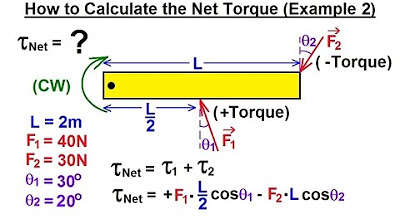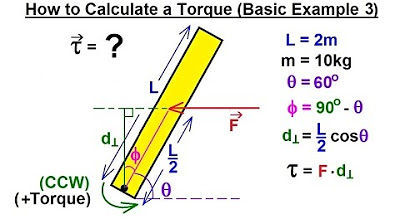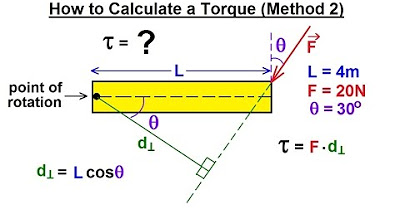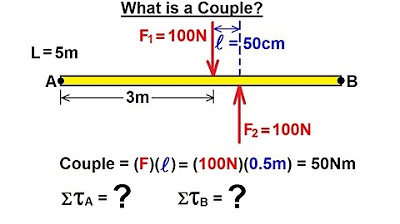Physics 15 Torque (9 of 27) Alternative Method 1 & 2: Example Torque=?
TLDRThe video script outlines a method for calculating the net torque acting on a beam, assuming the mass of the beam is negligible. It presents a scenario with three forces (F1, F2, F3) applied at different distances from a pivot point A along the beam. The forces are applied at angles of 30°, 45°, and 10° respectively, with magnitudes of 50, 40, and 60 Newtons. The calculation involves multiplying each force by its respective distance from the pivot and cosine of the angle, then summing these products to find the net torque. The process simplifies to 50N * cos(30°) * 3m - 40N * cos(45°) * 5m + 60N * cos(10°) * 10m, which results in a net torque of 579 Newton meters, indicating a counterclockwise direction. The video emphasizes the utility of this method, especially when it's easier to determine the perpendicular distance from the force's line of action to the pivot point, and encourages viewers to choose the method that best suits their needs.
Takeaways
- 📐 The example involves calculating the net torque on a beam with three forces acting on it, considering the distances from the pivot point and the angles of the forces.
- 🚫 The mass of the beam is considered insignificant, so it can be ignored in the torque calculation.
- ⚙️ The net torque is calculated by summing the individual torques caused by each force, taking into account their direction and magnitude.
- 🔵 The first force (F1) causes a counterclockwise motion, which is considered a positive torque, calculated as F1 * distance * cos(30°).
- 🔴 The second force (F2) results in a clockwise motion, indicating a negative torque, calculated as -F2 * distance * cos(45°).
- 🟢 The third force (F3) also causes a counterclockwise motion, which is a positive torque, calculated as F3 * distance * cos(10°).
- 🔢 The magnitudes of the forces are given as F1 = 50 Newtons, F2 = 40 Newtons, and F3 = 60 Newtons.
- 📏 The distances from the forces to the pivot point are 3 m for F1, 5 m for F2, and 10 m for F3.
- 🧮 The final calculation of the net torque is simplified by substituting the values for the forces and their respective distances and angles.
- 📊 The net torque is found to be 579 Newton meters, which indicates a counterclockwise direction due to its positive value.
- 🛠️ Two methods for finding torque are discussed: one using the perpendicular distance and the other using the line of action of the force to the pivot point.
- ✅ The choice of method depends on the user's preference and which one is more convenient for the specific problem at hand.
Q & A
What is the total length of the beam in the given example?
-The total length of the beam is 10 meters.
What is the distance from point A to where Force One is acting?
-The distance from point A to where Force One is acting is 3 meters.
How is the torque caused by the first force described in terms of direction?
-The first force causes a counterclockwise motion, which is described as a positive torque.
What is the formula used to calculate the torque caused by the first force?
-The formula used is F1 * b1 * cos(30°), where F1 is the magnitude of the force, b1 is the distance from the force to the pivot point, and cos(30°) is the cosine of the angle between the vertical and the force.
What is the angle used for the cosine calculation of the second force's torque?
-The angle used for the cosine calculation of the second force's torque is 45°.
Why is the torque caused by the second force considered negative?
-The torque caused by the second force is considered negative because its vertical component would result in a clockwise motion.
What is the total net torque acting on the beam, according to the final calculation?
-The total net torque acting on the beam is 579 Newton meters, which is a positive quantity indicating a counterclockwise direction.
What does the positive value of the net torque indicate about the direction of rotation?
-A positive value of the net torque indicates that the rotation would be in a counterclockwise direction.
Why can the mass of the beam be ignored in this calculation?
-The mass of the beam can be ignored because it is considered insignificant in the context of the problem, allowing for a simplification of the calculation.
What are the magnitudes of the three forces acting on the beam as given in the example?
-The magnitudes of the three forces are 50 Newtons for Force 1, 40 Newtons for Force 2, and 60 Newtons for Force 3.
How does one find the net torque using the method described in the script?
-The net torque is found by summing the individual torques caused by each force, taking into account their directions and the perpendicular distances to the pivot point.
What are the cosine values used for the forces in the final calculation?
-The cosine values used are cos(30°) for Force 1, cos(45°) for Force 2, and cos(10°) for Force 3.
Why might one choose to use this method over finding the perpendicular distance to the line of action of the force?
-One might choose to use this method when it is easier to determine the angle between the force and the vertical, rather than the perpendicular distance to the pivot point.
Outlines
🔍 Calculating Torque with Beam and Forces
This paragraph introduces a method for calculating the net torque on a beam with three forces acting on it. The beam is 10 meters long with distances of 3 meters, 5 meters, and 10 meters marked from a pivot point A. The forces are F1 (50 Newtons), F2 (40 Newtons), and F3 (60 Newtons), with F1 and F3 causing counterclockwise motion and F2 causing clockwise motion. The torque for each force is calculated by multiplying the force's magnitude by the distance to the pivot point and the cosine of the angle between the force and the vertical. The angles used are 30° for F1, 45° for F2, and 10° for F3. The final net torque is calculated after substituting the values, resulting in a positive 579 Newton meters, indicating a counterclockwise direction.
Mindmap
Keywords
💡Torque
💡Beam
💡Force
💡Distance
💡Pivot Point
💡Cosine
💡Counterclockwise
💡Net Torque
💡Newtons
💡Angles
💡Sum of the Torques
💡Direction of Rotation
Highlights
Different method of finding torque about a point demonstrated
Example involves a beam with three forces acting on it
Distances from point A to forces are 3m, 5m, and 5m
Total distance from point A to end of beam is 10m
Mass of beam is insignificant and can be ignored
Net torque is sum of torques about point A
First force (F1) causes positive (counterclockwise) torque
Second force (F2) causes negative (clockwise) torque
Third force (F3) causes positive (counterclockwise) torque
Torque calculation involves force magnitude, distance to pivot, and cosine of angle
Forces F1=50N, F2=40N, F3=60N at angles 30°, 45°, 10°
Plug in force and angle values to calculate net torque
Simplify the expression before calculating final answer
Net torque is 579 Nm, indicating counterclockwise rotation
Positive net torque means counterclockwise, negative means clockwise
Net torque about point A is also the net force on the beam at A
Two methods presented - choose the one that works best for you
This method is easier when finding the perpendicular distance is more straightforward
Demonstration shows step-by-step process for calculating torque using this method
Transcripts
Browse More Related Video

Physics 15 Torque Fundamentals (11 of 13) How to Calculate the Net Torque? Ex. 2

Physics 15 Torque Fundamentals (9 of 13) How to Calculate a Torque (Basic Example 3)

Physics 15 Torque Fundamentals (5 of 13) How to Calculate a Torque (Method 2)

Physics 15 Torque Fundamentals (8 of 13) How to Calculate a Torque (Basic Example 2)

Physics 15 Torque (6 of 27) What is a Couple?

Calculating Torque
5.0 / 5 (0 votes)
Thanks for rating: